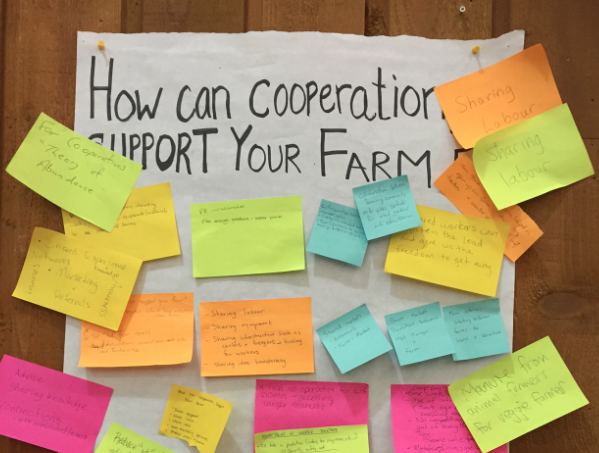This content has been archived as it may no longer be accurate or relevant.Trina McDonald, Concrete Garden; 31 March 2016
It’s fairly safe to say that no one becomes a farmer these days to get rich. Taking on the task of being a steward and change-maker of a notoriously messed up food system can be stressful and the drive to do so generally comes from one thing—passion. Yet, passion is not always enough to sustain a person. Farmers need each other.
The theme of this year’s Farmer2Farmer event was “Beyond Competition, Towards Cultures of Cooperation.” The conference, organized by the Capital Region Food and Agricultural Initiative Roundtable (CR-FAIR) in collaboration with the Young Agrarians, was held at Saanich Fair Grounds on March 1. The annual event provides an opportunity for farmers to network and share local knowledge, a radical act in a society that promotes competition for economic gain. Keynote speakers and workshop leaders added their voices to the compelling argument that cooperation is the answer to preventing farmer burnout and promoting food security.
Up until the mid-19th century, most farmers in North America still practiced subsistence farming, providing for themselves and their families from a small plot of land. Rural and urban farmers face a very different situation today. According to CR-FAIR Coordinator Linda Geggie, “a farmer needs to be not only a soil expert and good at growing, but they also have to need to know how to manage a business and do marketing and human resourcing, all within a very uncertain environment and that can be really stressful.”
In order to address the stress head on, Farmer2Farmer brought in Reg Steward from AgSafe BC to host a workshop called Managing Stress on the Farm, and to provide one-on-one support at the Ask the Expert table. Steward, whose cowboy hat and boots were well suited to his life as a rancher in the Chilcotin region, was on a mission to help farmers identify their stress. He reminded us that stress is not just in our heads, it’s a chemical and hormonal soup that wreaks havoc on the body.
The likelihood of getting injured or sick during peak season in a “straw that breaks the camel’s back” scenario increases when we fail to recognize we’re stressed, explains Stewart. For those living on the farm, Steward says, “work is not a place you leave but a place you look on” and while communication technology can increase productivity, it becomes harder to “put aside the world that presses in.” There is always one more email to respond to.
Trying to stay in control is the secret recipe for burnout. Steward points out that when we’re stressed we tend to lash out at those who could help us—our loved ones and collaborators. Mary Alice Johnson, owner of ALM farm and a founder of the Moss Street Market, echoes this. Addressing the conference, she said that people who try to control everything are not a good fit for collaboration. She emphasized the need for “peacemakers” and people who can be flexible when getting a big project, like a market, off the ground. Yet, farmers (and everyone else) can easily get into a vicious cycle where stress leads to poor communication and poor communication makes it difficult to work with others, which leads to more stress.
The infuriating answer to all this is to “just relax,” a difficult proposition when there are endless tasks to accomplish. Steward’s advice is equally straightforward but a dash of humour makes it easier to swallow. “You’re not the bees knees,” he says—in other words, you’re not as important as you think. Realizing other people can also do the job is a pre-requisite to asking for help. Delegating, making a phone-list of people to call for assistance, putting people on hold, and saying “no” were all strategies he offered for communicating boundaries and lightening the load.
There were many examples of the payoff of working with others. Both John Buchanan of Parry Bay Farm in Metchosin and Arzeena Hamir from Amara Farm in the Comox Valley spoke of the many gifts bestowed on them through their collaborative partnerships with other farmers.
Market forces indicate competition is good for business, but Buchanan and Hamir have found the opposite is true. “Being competitive would kill us in our high-cost environment” says Buchanan, who has success sharing hay, equipment, and wholesale marketing with a neighbouring farm. Hamir’s bottom line has improved and her customers receive more diverse products because she shares a farm stand and C.S.A (community supported agriculture) with two nearby farmers.
Perhaps even more importantly, the burden of farming is greatly reduced. Buchanan says he is having more fun and he and his partner can rely on each other if one of them needs to go away for a few days. Similarly, Hamir says sharing the task of going to market takes the weight off her shoulders and she loves working with “shiny young people.” It keeps her feeling youthful.
Farmer2Farmer is a great name for the conference. While opportunities to increase practical knowledge and skills in things like soil building and beekeeping were worth the entrance fee alone, at the end of the day the event builds resilience in farmers by building relationships between farmers, and happy farmers make a strong local food system.
Click here to see the original articleShare this Post

